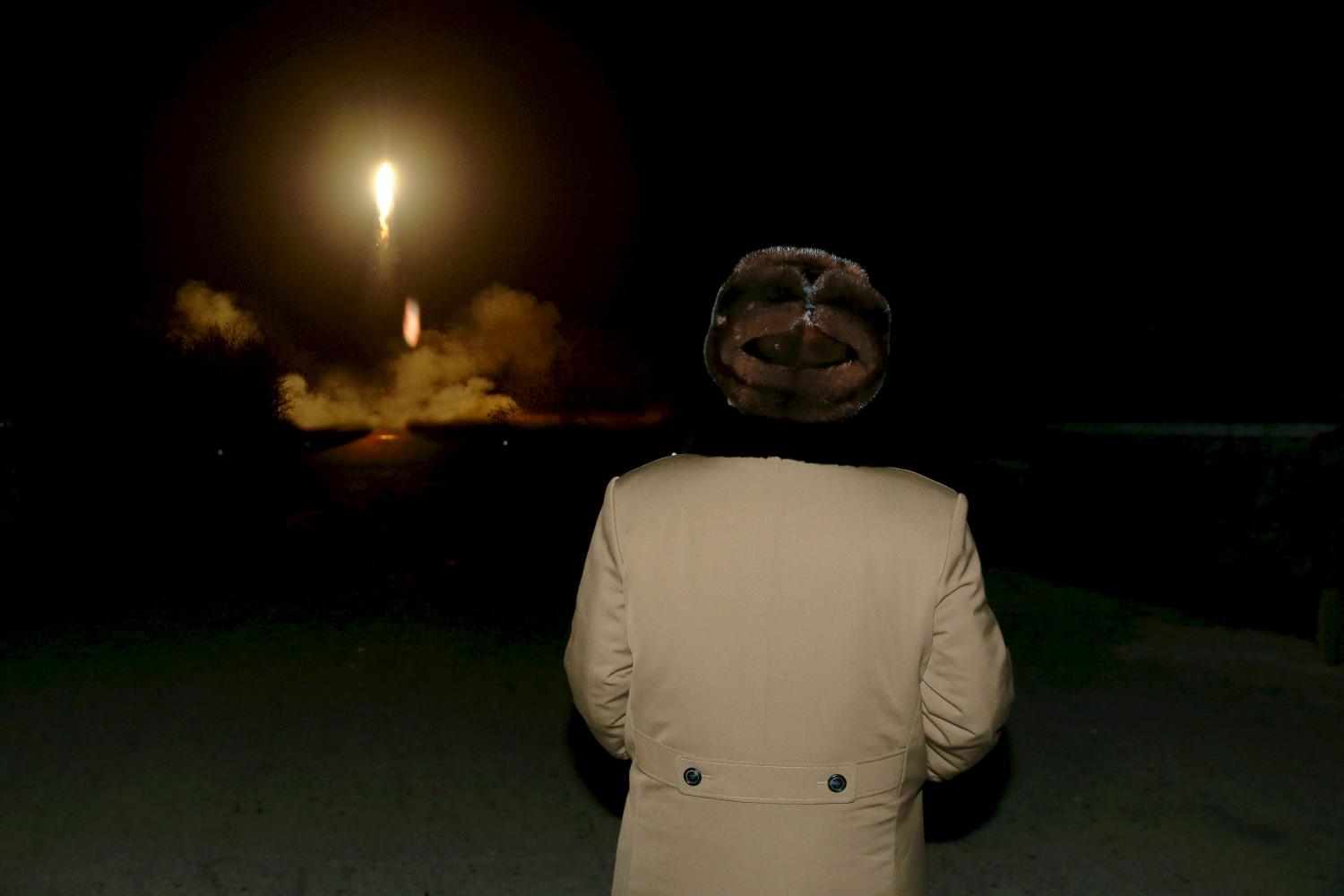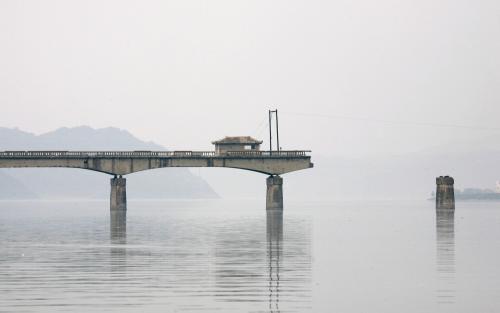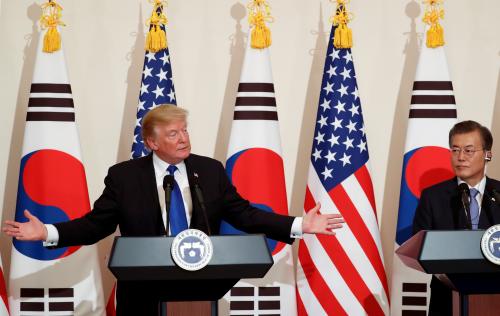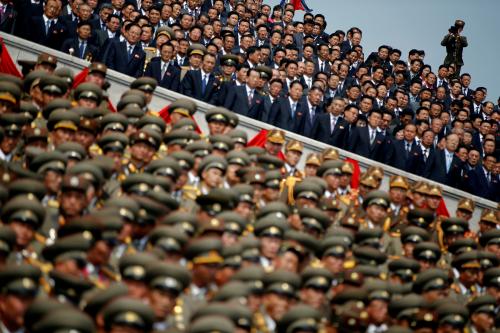The following brief is part of Brookings Big Ideas for America—an institution-wide initiative in which Brookings scholars have identified the biggest issues facing the country and provide ideas for how to address them. (Updated January 26, 2017)
 The rising threat posed by North Korea (Democratic People’s Republic of Korea; DPRK) requires a new approach that will force the regime to choose between nuclear weapons and survival. President Trump should make clear to North Korea that the United States is prepared to put at risk the one thing that the DPRK holds even more dear than its nuclear weapons—the preservation of its regime—to compel Pyongyang to end its nuclear weapons program. To implement this approach, the United States should aggressively pursue the financial lifeblood of the Kim regime, starve it of foreign currency, cut Pyongyang off from the international banking and trading systems, greatly intensify sanctions, interdict its illicit commerce, and use covert means to exploit the regime’s vulnerabilities. The military dimension of U.S. policy will be equally important.
The rising threat posed by North Korea (Democratic People’s Republic of Korea; DPRK) requires a new approach that will force the regime to choose between nuclear weapons and survival. President Trump should make clear to North Korea that the United States is prepared to put at risk the one thing that the DPRK holds even more dear than its nuclear weapons—the preservation of its regime—to compel Pyongyang to end its nuclear weapons program. To implement this approach, the United States should aggressively pursue the financial lifeblood of the Kim regime, starve it of foreign currency, cut Pyongyang off from the international banking and trading systems, greatly intensify sanctions, interdict its illicit commerce, and use covert means to exploit the regime’s vulnerabilities. The military dimension of U.S. policy will be equally important.
This approach is risky and will complicate relations with China, which sees Pyongyang as an asset in its rivalry with the United States. Importantly, however, America’s South Korean ally appears willing to assume more risk to end the North’s threat. However, political developments in South Korea (Republic of Korea; ROK) will bear careful watching and there is some potential for a political shift in Seoul that could find the United States at odds with a new, center-left government. The Trump administration should carefully listen to South Korean concerns and not take the South for granted. With a rising North Korean threat, America will need allies. Building strong ties with Seoul will be critical to ensuring that Washington and Seoul stay on the same page and pursue an effective policy against Pyongyang.
The Threat
A nuclear-armed North Korea will present the Trump administration with one of its most urgent foreign policy and security challenges. President Trump will face a more dangerous North Korea than did any of his predecessors. He will also inherit a legacy of U.S. policy failure in dealing with Pyongyang’s nuclear ambitions.
America now faces the nightmare of a nuclear-armed North Korea that is threatening to use those weapons.
Four U.S. administrations have tried and failed to stop North Korea’s pursuit of nuclear weapons. Pyongyang has been offered incentives, presidential assurances, and security guarantees on the one hand, and Washington has also tried sanctions, threats, and isolation on the other. Nothing has worked more than temporarily. As a result, America now faces the nightmare of a nuclear-armed North Korea that is threatening to use those weapons.
North Korea can probably already target South Korea, Japan, and U.S. bases in those countries with nuclear-tipped ballistic missiles. And Pyongyang will likely be able to strike more distant targets, including U.S. bases in Guam and Hawaii, and eventually the continental United States itself, within two to three years. Meanwhile, North Korea is also developing solid-fuel ballistic missiles that would enable it to disperse and hide those missiles and give the regime a survivable second-strike capability.
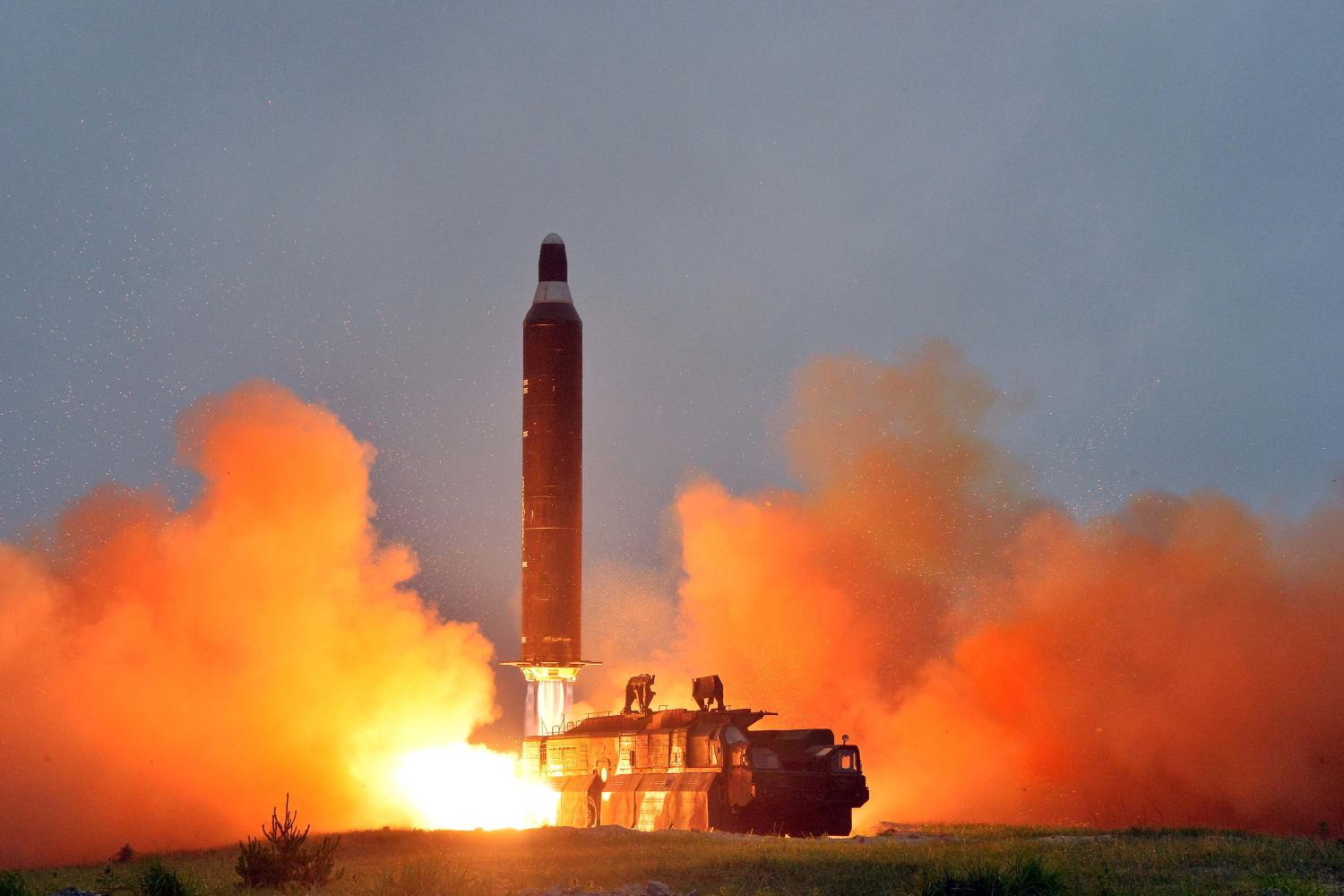
What Does Pyongyang Want?
What is Pyongyang’s goal in building nuclear weapons? For years, some argued that Pyongyang’s nuclear weapons were “bargaining chips” to be “traded” for aid, concessions, and inducements, including diplomatic normalization and security guarantees. But over the years, U.S. diplomats negotiating with North Korea came to realize that incentives were of little value. They discovered that Pyongyang was not building nuclear weapons just to trade them away.
Today, we know that nuclear weapons fulfill two core requirements for the regime. First, nuclear weapons ensure the regime’s survival. Pyongyang is convinced that the United States will not attack a country that has nuclear weapons and is prepared to use them. But a second reason for North Korea’s nuclear weapons and missiles now seems clear: DPRK representatives say privately that, thanks to their nuclear weapons, they have the United States “deterred.” They assert that the United States must now live with a nuclear-armed North Korea and accept its demand to negotiate a peace treaty to replace the Korean War armistice agreement and conduct U.S.-DPRK “arms control talks.” The goal of these talks, they declare, would be to remove the U.S. “threat,” which they define as the U.S.-ROK alliance, American troops in South Korea, and the U.S. “nuclear umbrella.”
Pyongyang’s message to the United States is: “We are willing to risk nuclear war to achieve our goals, are you?”
Pyongyang appears to believe that its nuclear weapons have fundamentally changed the dynamics of U.S.–North Korea relations. Pyongyang thinks it can now compel Washington to end the U.S.-ROK alliance and remove the U.S. extended deterrent, allowing the North to achieve its ultimate goal: the reunification of the peninsula on its terms. And by threatening to use nuclear weapons, Pyongyang’s message to the United States is: “We are willing to risk nuclear war to achieve our goals, are you?”
Pyongyang’s belief that it has changed the balance of forces on the Korean Peninsula is troubling. So, too, is its desire to leave the United States with no alternative but to deal with a nuclear-armed North Korea. That is why it has declared the goal of denuclearization dead, and why the North says it will continue to expand its nuclear arsenal. By making its intentions explicit, Pyongyang hopes to force the United States to choose between accepting a nuclear-armed North or risking war to prevent it.
The China Factor
Many believe that Beijing is the key to solving the North Korea nuclear challenge, but China is increasingly part of the problem. We have probably reached the limits of Beijing’s willingness to do more to pressure the DPRK. Chinese cooperation in implementing international sanctions has been grudging and filled with loopholes, and efforts to approve a tough UN Security Council resolution after Pyongyang’s fifth nuclear test were fraught with difficulties.
China’s position on North Korea is increasingly driven by broad, geopolitical factors, especially Beijing’s growing strategic rivalry with the United States. In this context, China’s leaders do not necessarily see North Korea as a liability. For that matter, China’s leaders continue to believe it is better to keep a troublesome North Korean ally afloat than to risk the chaos that might result if the regime collapses.
Accordingly, the United States should be modest in its expectations of China when it comes to pressuring Pyongyang. Washington should also avoid characterizing North Korea as “China’s problem” to solve. Pyongyang’s nuclear weapons are aimed at U.S. bases and U.S. allies, and soon will target the U.S. homeland. For that reason alone, subcontracting America’s security to a Beijing that is inclined to sympathize with Pyongyang would be a grave mistake. Instead, when Beijing repeats the familiar mantra that it has “little influence” over North Korea, U.S. policymakers should respond that China’s inability (or unwillingness) to act makes it necessary for the United States and its allies to do so as a matter of self-defense.
The new administration should also recognize that steps it takes to intensify sanctions on Pyongyang, including targeting Chinese companies that are violating sanctions, could complicate U.S.-China relations. But these concerns cannot be allowed to prevent the United States from defending its interests.
U.S. Policy Options: Pluses and Minuses
So what is to be done? The list of policy options the Trump administration will consider is an unsatisfying one. It includes choices that are deficient, defunct, dangerous, defeatist, and even delusional. Here are several possible options.
“Staying the Course-Plus”
First, the new administration could pursue a version of recent policy and gradually increase sanctions on North Korea and hope the cumulative effect of sanctions over time will convince Pyongyang to resume denuclearization talks. However, this approach has not worked, and is not likely to work in an acceptable timeframe, as Pyongyang’s nuclear and missile threats become increasingly urgent in the coming months. And with North Korea having rejected denuclearization dialogue and made clear its determination to rapidly expand its nuclear arsenal, gradualism is unlikely to work.
Military Action
The United States and South Korea could take military action against North Korea, destroying its known nuclear, missile, and military infrastructure, including nuclear production and storage facilities. Such an attack would leave the DPRK incapable of mounting a significant conventional counterattack and render its army largely ineffective as a fighting force. But North Korea could still inflict major damage on South Korea, and even a broadly successful air campaign would not guarantee that North Korea could not use its nuclear or other weapons of mass destruction against South Korea, Japan, and U.S. bases. Military action against North Korea is a dangerous option that could undermine regional stability, risk a conflict with China, create peninsula-wide chaos, and cause major damage to our South Korean ally.
Living with a Nuclear North Korea
Some argue that the United States should accept the inevitability of a permanently nuclear-armed DPRK. In this view, the United States could opt to live with a nuclear North Korea and rely on containment and deterrence to defend itself and its allies and prevent nuclear proliferation.
Doing so would reverse decades of U.S. policy. It would damage, perhaps fatally, the international nuclear nonproliferation regime and emasculate the Nuclear Nonproliferation Treaty (NPT). It would shake the confidence of America’s South Korean and Japanese allies, who refuse to accept Pyongyang’s nuclear status. Calls would escalate in both Seoul and Tokyo to develop nuclear weapons. This approach would allow Pyongyang to continue to enhance its nuclear and missile arsenals to threaten U.S. allies. The North’s temptation to engage in proliferation would be strong, especially since the fabric of the NPT had been damaged and American resolve was in question. Accepting the North as a de facto nuclear weapons state would make things worse, not better.
A New Goal for Dialogue?
What about accepting Pyongyang’s proposal to discuss replacement of the Korean War Armistice Agreement with a peace treaty, instead of or in advance of a denuclearization discussion? A peace treaty would defuse tensions, it is said, and would convey U.S. seriousness about dealing with Pyongyang’s concerns and remove what Pyongyang claims is the “root cause” of its development of nuclear weapons.
Such thinking is delusional. Accepting North Korea’s proposal would damage ties with the ROK, which is not prepared to negotiate a peace treaty with a nuclear-armed DPRK. And Seoul surely would not accept a peace treaty discussion in which it is not a central player. Moreover, entering a peace treaty discussion with a nuclear North Korea and foregoing denuclearization discussions would buy into the North Korean game plan mentioned earlier. North Korea wants a peace treaty that leads to the end of the U.S.-ROK alliance. The Trump administration cannot accept this.
A “Freeze”
For some, “freezing” or “capping” the North Korean nuclear program and trying to eliminate it over time through dialogue should be the goal.
It is important to recall that a freeze leading to denuclearization was the central premise of both the October 1994 Agreed Framework and the September 2005 six-party agreement. Both efforts failed. Importantly, a credible freeze or cap is only as good as our ability to verify it, and North Korea has made clear it will not accept international verification. U.S. inability to verify a freeze would leave North Korea’s uranium enrichment facilities in operation. Pyongyang would also be free to improve its warheads, manufacture larger warheads, and make other refinements to its nuclear weapons during a so-called freeze. A freeze that does not halt the testing and deployment of ballistic missiles also would allow Pyongyang to continue to improve its delivery systems.
If the goal of a freeze is to prevent the North from making additional nuclear weapons, it will not work. It would leave the United States and its allies dangerously vulnerable. Unless a temporary freeze on nuclear testing and plutonium production is part of a firm agreement that leads quickly to complete and verifiable denuclearization, it runs the risk of creating the illusion of security and progress where none exists.
“Nukes for Everybody”
Finally, some have suggested that the solution is to allow Japan and South Korea to develop their own nuclear weapons. This proposal is ill advised and dangerous and would lead to the further deterioration of the NPT and provide justification for Pyongyang to keep its nuclear weapons. When a dangerous resident is threatening to blow up the neighborhood, responding to the threat by giving everyone in the neighborhood a can of gasoline and matches is unlikely to be an effective approach.
Time for a Different Approach
The Trump administration needs a new approach. And the rapidly rising danger from Pyongyang requires the United States to adopt a strategy that reflects the growing urgency of the threat. The United States must apply immediate and unprecedented pressure on the North Korean regime to compel it to change course.
Going forward, U.S. policy should be built on a much stronger foundation than exists today, one that includes the following strategies:
- Deploying improved U.S. and allied military capabilities on and around the Korean Peninsula;
- Enhancing extended deterrence and measures to physically demonstrate U.S. determination to fulfill its commitments; and
- Increasing the scope and frequency of military exercises, to include participation by other members of the UN command, such as the United Kingdom and Australia.
North Korea must be convinced that it will never be accepted as a nuclear state and that the United States is prepared to respond with steps designed to deter and contain any of the North’s nuclear activities, and that the United States will raise the cost to Pyongyang of its pursuit of nuclear weapons to an unacceptable level. U.S. policy should make clear that Washington’s preference is for the resumption of meaningful dialogue with Pyongyang, and that the United States stands by past agreements to eventually normalize relations with a nonnuclear DPRK. The United States should assure Pyongyang that it is prepared to engage at the highest levels with the DPRK to address the full range of its concerns, if and only if Pyongyang is prepared to reopen a serious denuclearization dialogue.
To do this, the United States should be prepared to hold at risk the one thing that the DPRK holds more dearly than its nuclear weapons—the preservation of its regime—in order to convince Pyongyang to end its pursuit of nuclear weapons. North Korean officials say their goal is the preservation of their regime, and they believe nuclear weapons will help them achieve this goal. The United States must convince Pyongyang otherwise. U.S. policy should emphasize a central new message to Pyongyang: If regime survival is your goal, nuclear weapons will prevent you from reaching this goal.
The Toolkit
The tools to convince North Korea to take a different path include greatly strengthened economic, trade, financial, and other measures designed to starve the Pyongyang regime of hard currency and disrupt its companies’ ability to do business in violation of UN and other sanctions.
Sanctions on North Korea should be intensified to the level once applied on Iran. This should not be done in an incremental way, but as quickly as possible to achieve maximum effect. The United States and like-minded countries should expel North Korea from the international banking system, including denying Pyongyang access to the global financial transaction clearing system. Secondary sanctions should be applied on third-country entities, including Chinese firms, that do business with suspect North Korean entities. Existing authorities under UN Security Council resolutions and relevant unilateral sanctions should be used to pressure and, if possible, shut down firms, including travel and tourism companies, currently doing business in North Korea.
The international community should intensify inspection and interdiction of suspect North Korean vessels and aircraft, and third-country vessels and aircraft trading with the DPRK. The United States also should consider imposing a naval quarantine to prevent North Korea from violating existing UN Security Council sanctions or trading in illicit materials.
Overseas North Korean assets should be frozen or seized if they are linked to illicit activities or violation of UN Security Council sanctions. Surveillance of overseas DPRK trading offices should be increased with an eye toward shutting these offices down in cases where they violate sanctions. The United States should encourage the international community to stop trading with North Korea and be prepared to exclude from the U.S. market firms that do business with North Korea.
Other, more technical efforts can be made against North Korea’s domestic and foreign vulnerabilities. Using new U.S. legislation that calls for an increase in information operations against the DPRK, the United States and its partners should explore vulnerabilities in the DPRK’s cellphone system to maximize the flow of information into the country. Efforts also should be made to encourage overseas representatives of the DPRK to defect and to cooperate with international law enforcement to stop illicit trade and other activities. Covert activities designed to exploit vulnerabilities in the DPRK’s communications, banking, and financial systems should be considered—but the less said publicly about these measures, the better.
A Word about Risk and Uncertainty
The above policy recommendations carry some risk, but the risk of allowing North Korea to increase its nuclear threat is much greater. The Trump administration must be prepared to act from the outset with a sense of urgency, determination, and intensity, especially since Pyongyang may challenge it early on.
No country knows the risks associated with the above approach better than South Korea. Importantly, Seoul’s consistent message to Washington in recent months has been one of firm determination and a clear willingness to accept the risks. But South Korea’s recent political crisis has created uncertainty about its ability to stay the course, and we cannot rule out the possibility that a successor, center-left South Korean government might opt for a different approach to deal with Pyongyang. This bears careful watching.
The new U.S. administration must carefully consider South Korea’s concerns, sensitivities, and politics. As the Trump administration works with Seoul to coordinate next steps against North Korea, it must avoid alienating our important ally or taking it for granted. The administration should also avoid fueling South Korean fears that Washington might abandon its ally. The words of reassurance President-elect Trump used in his postelection call with South Korea’s President Park were important—and absolutely necessary.
In the current atmosphere of continuing uncertainty about how the United States views alliances, providing reassurance to America’s best friends is essential. As the United States faces the rising danger of a nuclear-armed North Korea, it will need partners. The new administration must prioritize building the closest possible ties of trust and confidence with its allies, particularly South Korea, which has always stood shoulder-to-shoulder with the United States. Therein lies the best hope for success in dealing with North Korea.

